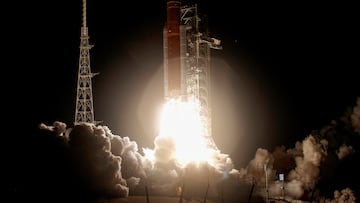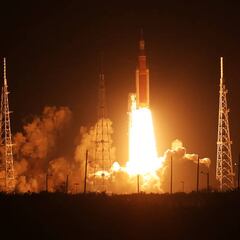How long will it take Artemis 1 to get to the moon?
The rocket was finally able to leave the launchpad after a number of delays and it won’t be long until it reaches its target.


NASA has finally got its Artemis programme off the ground, literally. The rocket finally launched on Wednesday after multiple setbacks.
“What an incredible sight to see NASA’s Space Launch System rocket and Orion spacecraft launch together for the first time,” said NASA Administrator Bill Nelson. “This uncrewed flight test will push Orion to the limits in the rigors of deep space, helping us prepare for human exploration on the Moon and, ultimately, Mars,”
OH MY GOODNESS!#Artemis pic.twitter.com/OhgKIFHMmK
— Nick Stewart (@NStewCBS2) November 16, 2022
The US space agency had tried multiple times to launch the mission prior to Wednesday. Already last August they were forced to abort the mission due to a series of technical failures. Last September the same thing happened, this time due to weather conditions. The launch was again postponed to Monday 14 November when more adverse weather meant that the mission went ahead two days later..
It will still be some days before Artemis 1 reaches the Moon. The distance itself is a whopping 450,000 km (279,617 miles) or the same distance as 5,666,906 football pitches.
It is expected to take between eight to 14 days for Artemis to reach the Moon. It won’t be landing on the surface, instead it will slingshot around the Moon before returning to Earth mid-December. The whole mission should take 26 days.
Find out more about the Artemis mission
What is the Artemis 1 programme?
Artemis is the mythological Greek goddess of the Moon and the hunt and twin sister of Apollo, the name of the series of Moon missions some 50 years ago. Orion, the crewed craft, is the hunting mate of Artemis.
Related stories
Should Artemis 1 successfully complete its mission then it will be full-steam ahead for future astronauts to once again touch down on the lunar surface. It will also begin the process of humans establishing a long-term presence on our neighboring satellite to prepare for an eventual manned mission to Mars. While Artemis I is unmanned, it will give the US space agency an opportunity to test the Space Launch System (SLS), the most powerful rocket in the world.
NASA’s Artemis is in flight.
— President Biden (@POTUS) November 16, 2022
This ship will enable the first woman and first person of color to set foot on the lunar surface and will lead countless students to become explorers and show America’s limitless possibilities to the world. pic.twitter.com/mIEZdVcB6M
The mission’s stated purpose for going back to the Moon is “scientific discovery, economic benefits, and inspiration for a new generation of explorers: the Artemis Generation. While maintaining American leadership in exploration, we will build a global alliance and explore deep space for the benefit of all.”

